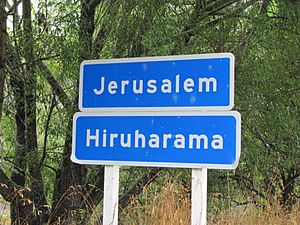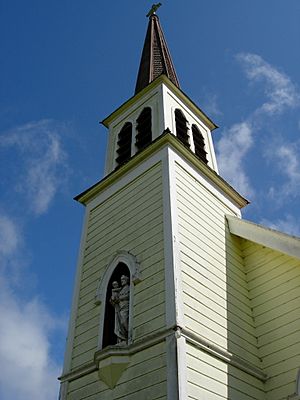Jerusalem, New Zealand facts for kids
Quick facts for kids
Jerusalem
|
|
|---|---|
 |
|
| Country | New Zealand |
| Region | Manawatū-Whanganui |
| District | Whanganui District |
| Community | Whanganui Rural Community |
| Electorates |
|
| Time zone | UTC+12 (NZST) |
| • Summer (DST) | UTC+13 (NZDT) |
| Area code(s) | 06 |
Jerusalem is a small settlement in New Zealand. It's located about 66 kilometers up the Whanganui River from the city of Whanganui. Its name comes from the Biblical city of Jerusalem. In the Māori language, it is called Hiruhārama.
Long ago, in the 1840s, Jerusalem was known as Patiarero. It was one of the biggest settlements along the Whanganui River. Hundreds of Ngāti Hau people, who are part of the iwi (tribe) Te Āti Haunui-a-Pāpārangi, lived there. Unlike other places that got Māori names translated from English, Jerusalem usually uses its English name. Over time, it grew into smaller communities like Roma (named after Rome) and Peterehama (named after Bethlehem). These communities were formed by people who became Catholic after a Roman Catholic mission was built in 1854.
In 1892, a special group of nuns called the Sisters of Compassion was started in Jerusalem by Suzanne Aubert. She was also known as Mother Mary Joseph. These sisters became very well-known for their caring work, especially in nursing. Today, a convent and a church still stand on the mission property. The original church burned down in 1888, but a new one was built. The Sisters of Compassion continue to look after these important buildings. Wiremu Te Āwhitu, the first Māori Catholic priest, served at the church from 1968 to 1989.
In 1970, a famous New Zealand poet named James K. Baxter started a community in Jerusalem with some of his followers. This community ended in 1972 after Baxter passed away. He is buried there.
Jerusalem is also home to two important Ngāti Hau marae (meeting grounds). These are Hiruhārama or Patiarero Marae, which has the Whiritaunoka meeting house, and Peterehema Marae, which has the Upokotauaki meeting house.
Contents
People and Community
The area around Jerusalem is called Upper Whanganui. It covers a large space of about 1849.89 square kilometers. In 2018, about 1,155 people lived in this area.
The people living in Upper Whanganui come from different backgrounds. In 2018, about 73.2% were European/Pākehā, and 40.5% were Māori. Some people also identified as Pacific peoples or Asian. Many people in New Zealand have more than one ethnic background.
Most people in the area (46.8%) said they had no religion. About 40.0% were Christian, and 3.6% followed Māori religious beliefs.
Jerusalem Foundling Home
Starting in 1891, the Sisters of Compassion in Jerusalem began taking in abandoned children from all over New Zealand. Many of these children had parents who were not married or were widowed. Sometimes, the children were sent to the convent without their parents' names being known. In 1896, this place became officially known as the Jerusalem Foundling Home.
Children who were old enough to go to school attended the settlement school. This school was run by the Sisters of Compassion. Children from the local marae also went to this school. The Home wanted to be recognized as an Industrial School, which would allow them to get money from the government to care for the children. However, they couldn't get this official status. So, from 1891 to 1895, the children were listed on the rolls of Industrial Schools in Nelson and Upper Hutt, but they actually stayed at the convent in Jerusalem.
From 1885, the Jerusalem settlement also started taking in newborn babies. This was a time when there was a lot of talk about "baby farming," which was when people took money to care for babies but often didn't look after them well. Suzanne Aubert, who led the Jerusalem Foundling Home, believed it was very important to keep parents' names private. She thought this would keep both the parents and their children safe. The Home's official register didn't list the parents' names. However, Aubert kept a private list with this information in case parents wanted to find their children later. Because of this secrecy, the Home couldn't get money from the government. The law at the time said that registers had to list parents' names and be open for government checks.
In 1898, there was an investigation into the deaths of seven babies at the Home. Doctors at the time thought the babies died from measles or from milk that wasn't clean. During this investigation, the Home was criticized for not being open with government inspectors.
Famous People from Jerusalem
- Suzanne Aubert: She started the Sisters of Compassion religious group in Jerusalem in 1892.
- Earl Bamber: Born in 1990, he is a racing car driver who learned to drive in Jerusalem.
- James K. Baxter: A well-known poet and writer. He started a community in Jerusalem in 1970 and was buried there.
- Wiremu Te Āwhitu: Born in 1914, he was the first Māori person to become a Roman Catholic priest. He lived in Jerusalem from 1968 to 1989.
Climate and Weather
Jerusalem has a varied climate. Here's a quick look at the average temperatures and rainfall:
| Climate data for Jerusalem (1951–1980) | |||||||||||||
|---|---|---|---|---|---|---|---|---|---|---|---|---|---|
| Month | Jan | Feb | Mar | Apr | May | Jun | Jul | Aug | Sep | Oct | Nov | Dec | Year |
| Mean daily maximum °C (°F) | 23.6 (74.5) |
23.7 (74.7) |
22.2 (72.0) |
18.2 (64.8) |
14.4 (57.9) |
12.0 (53.6) |
11.7 (53.1) |
13.2 (55.8) |
15.3 (59.5) |
17.3 (63.1) |
19.5 (67.1) |
21.7 (71.1) |
17.7 (63.9) |
| Daily mean °C (°F) | 17.3 (63.1) |
17.9 (64.2) |
16.3 (61.3) |
13.0 (55.4) |
10.0 (50.0) |
7.8 (46.0) |
7.1 (44.8) |
8.7 (47.7) |
10.3 (50.5) |
11.7 (53.1) |
13.7 (56.7) |
15.8 (60.4) |
12.5 (54.4) |
| Mean daily minimum °C (°F) | 10.9 (51.6) |
12.0 (53.6) |
10.4 (50.7) |
7.8 (46.0) |
5.5 (41.9) |
3.6 (38.5) |
2.5 (36.5) |
4.2 (39.6) |
5.3 (41.5) |
6.1 (43.0) |
7.9 (46.2) |
9.9 (49.8) |
7.2 (44.9) |
| Average rainfall mm (inches) | 93 (3.7) |
119 (4.7) |
103 (4.1) |
86 (3.4) |
146 (5.7) |
152 (6.0) |
170 (6.7) |
152 (6.0) |
116 (4.6) |
116 (4.6) |
118 (4.6) |
189 (7.4) |
1,560 (61.5) |
| Source: NIWA | |||||||||||||


